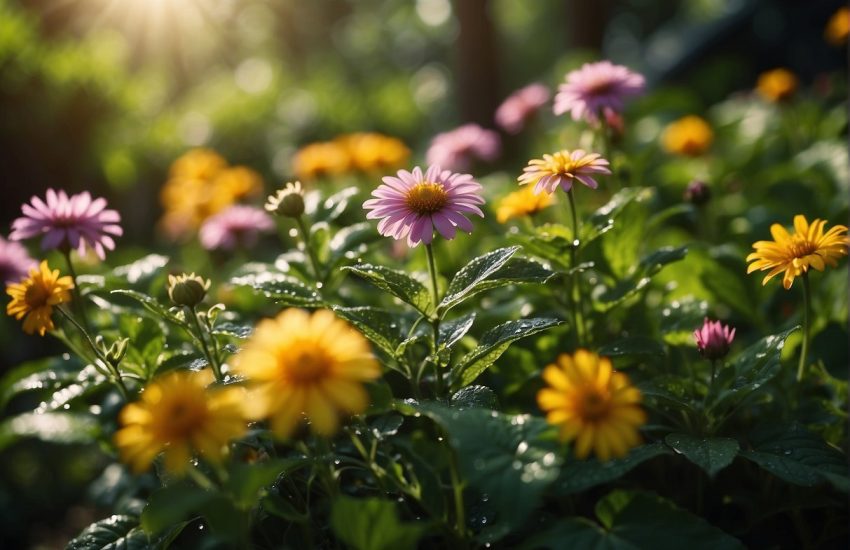Our Favorite Ground Cover Plants to Grow in Virginia
Ground covers are an important part of any garden, providing essential benefits such as erosion control, weed suppression, and soil stabilization. There are various ground covers to choose from, each with its distinct set of characteristics. However, to improve the chances of success and the survival of these plants, selecting one best suited for your locality is important. Here are some ground cover plants that can thrive in Virginia.
Creeping Phlox (Phlox stolonifera)
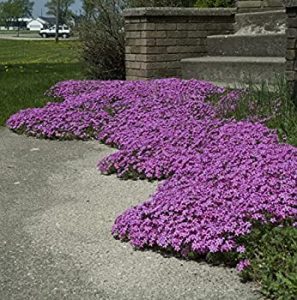
Phlox stolonifera, commonly known as Creeping Phlox, is a perennial flowering plant native to the southeastern United States. Growing 6-12 inches tall, it is a low-growing, mat-forming subshrub that spreads rapidly by stolons (runners). The glossy, dark green leaves are oval and about 1 inch long. In late spring or early summer, the plant produces masses of stunning 5-petaled flowers in shades of pink, purple, blue, or white. The flowers are borne on slender stems above the foliage and attract bees, butterflies, and hummingbirds. Creeping Phlox can become invasive if left unchecked as it will readily self-seed and spread vegetatively. However, with regular pruning and deadheading, it can be easily controlled. Creeping Phlox is an easy-to-grow groundcover that thrives in full sun to partial shade and well-drained soil. It is tolerant of heat and humidity and is pest and disease-resistant. Once established, it is quite drought tolerant. With its showy flowers and ability to spread rapidly, Creeping Phlox is an excellent choice for covering large areas of ground or filling in bare spots in the landscape. It also makes a beautiful addition to rock gardens, mass plantings, slopes, and foundations.
Wild Ginger (Asarum canadensis)
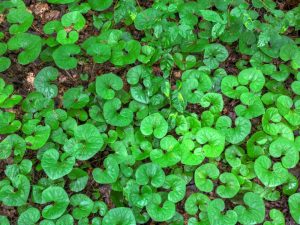
Asarum canadensis, commonly known as Wild Ginger, is a perennial flowering plant native to North America. Growing 12-18 inches tall, it is a low-growing herbaceous plant that spreads slowly by rhizomes. The heart-shaped leaves are dark green and have a leathery texture. In late spring or early summer, the plant produces small, brownish-purple flowers that are borne on short stems beneath the foliage. The flowers are not particularly showy, but they are fragrant and attract bees, flies, and other pollinators. Wild Ginger is a shade-loving plant that thrives in moist, well-drained soils. It is tolerant of drought and does not tolerate full sun. Once established, it is quite low maintenance. With its aromatic leaves and attractive foliage, Wild Ginger is an excellent choice for shady areas of the landscape. It also makes a nice addition to woodland gardens or naturalized areas.
Creeping Sedge (Carex laxiculmus)

Creeping Sedge (Carex laxiculmus) is a perennial sedge that is native to North America. It is a member of the Cyperaceae family and is closely related to other sedges such as the Common Sedge (Carex vulpinoidea) and the Purple Sedge (Carex peduncularis). The Creeping Sedge grows in moist, shady areas and is often found in woods, meadows, and along streams. This sedge gets its name from its habit of creeping along the ground, and it can form large mats if left unchecked. The leaves of the Creeping Sedge are linear and have a distinctive V-shaped cross-section. They are green in color with a white midrib, and they can grow up to 12 inches long. The flowers of this sedge are small and green, and they are borne in spikes that are arranged in a spiral pattern. The fruits of the Creeping Sedge are dry, winged seeds that are known as achenes. The wind disperses these seeds, and they can travel long distances from their parent plant. The Creeping Sedge is a low-growing plant that does not require much maintenance. It can be an excellent ground cover in areas where other plants have difficulty growing. This sedge is also sometimes used as a turfgrass alternative and is known for its ability to tolerate heavy foot traffic.
Perennial Peanut (Arachis glabrata)

Perennial Peanut (Arachis glabrata) is a perennial legume that is native to South America. It is a member of the Fabaceae family and is closely related to other peanuts, such as the Common Peanut (Arachis hypogaea) and the Runner Peanut (Arachis pintoi). The Perennial Peanut is a fast-growing plant that can reach heights of 18 inches or more. It has dark green, oval-shaped leaves arranged in pairs along the stems. The flowers of this plant are small and yellow, and they are borne in clusters at the ends of the stems. The fruits of the Perennial Peanut are dry, leathery pods that contain two or three seeds. Animals and birds disperse these seeds and can travel long distances from their parent plant. The Perennial Peanut is a hardy plant that can be grown in a variety of soil types. It is tolerant of drought and poor drainage and can even tolerate salt spray. This legume is often used as a cover crop or green manure and is known for its ability to fix nitrogen in the soil. The Perennial Peanut can also be used as a forage crop and is an excellent choice for hay production.
Hairy Alumroot (Heuchera villosa)

Hairy Alumroot (Heuchera villosa) is a member of the saxifrage family, which also includes stonecrops and sedums. A native of North America, it is found in woodlands from Quebec to Minnesota and south to Kentucky and Tennessee. The hairy alumroot gets its name from its hairy leaves, which are covered with tiny hairs that help to reflect sunlight and prevent water loss. The leaves are dark green and deeply lobed, with ruffled edges. In late summer, the plant produces tall spikes of small white flowers. The hairy alumroot is a perennial plant that will come back year after year. It is a low-maintenance plant that is easy to care for and does not require much fertilizer or water.
Golden Ragwort (Packera aurea)
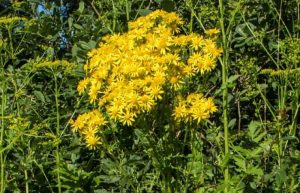
Golden Ragwort (Packera aurea) is a beautiful flowering plant native to North America. It gets its name from its brightly colored flowers, which range in hue from deep yellow to golden-orange. The plant grows to be about 1-2 feet tall and has deeply lobed leaves. Golden Ragwort blooms in late spring or early summer and is often used as ornamental garden plants. The flowers are attractive to bees and butterflies, making Golden Ragwort a valuable addition to any pollinator garden. This plant is relatively easy to grow and does not require much maintenance. This plant prefers full sun to partial shade and moist to mesic conditions. It is a good source of nectar for bees and other pollinators. Birds also eat the seeds. Golden Ragwort can be propagated by seed or division, which is considered an ornamental plant.
Foamflower (Tiarella cordifolia)
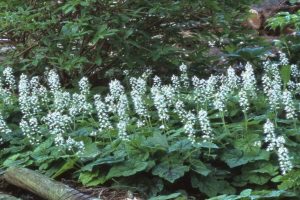
Foamflower (Tiarella cordifolia) is a herbaceous perennial. It is a member of the Saxifragaceae family and grows to 12-18 inches tall. The leaves are basal, broadly cordate, and palmately lobed with 3-5 deep lobes. The leaf margins are serrated, and the upper surface is pubescent.
Foamflowers are native to North America and grow in woodlands from Canada to the Appalachian Mountains. The plants get their name from the white, frothy flowers that bloom in early spring. These flowers are followed by attractive green foliage that turns a rich bronze in autumn. Foamflowers are both deer and rabbit-resistant and make an excellent ground cover for shady areas. They will also tolerate some sun but prefer moist, well-drained soil. Foamflowers are hardy Plants that will come back year after year with very little care. Simply cut back the plants in late winter or early spring, and they will reward you with an abundance of blooms in the springtime. With their beauty and versatility, foamflowers are a must-have for any gardener’s repertoire.
Green-and- Gold (Chrysogonum virginianum)
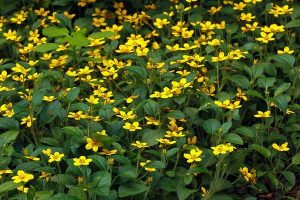
Green-and-Gold (Chrysogonum virginianum) is a beautiful native wildflower that can be found in woodlands, meadows, and gardens across the eastern United States. The plant gets its name from its distinctive flower – each blossom has a golden center surrounded by a ring of green petals. The flowers appear in spring and summer, and bees and butterflies often visit them. Green-and-Gold is a low-growing plant, typically reaching a height of 12-18 inches. The leaves are broad and somewhat heart-shaped, with a toothed margin. The plant spreads via underground rhizomes, and it can form large colonies over time. Green-and-Gold is easy to grow and care for, making it a popular choice for gardeners of all levels of experience.
Fragrant sumac (Rhus aromatica)
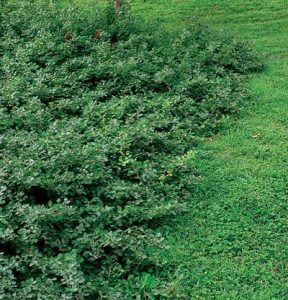
Fragrant Sumac (Rhus aromatica) is a small deciduous shrub that is native to North America. The plant typically grows to between 3 and 6 feet tall, with fragrant, compound leaves. The flowers are small and yellow and bloom in clusters in late spring or early summer. In fall, the leaves turn a beautiful red, making the plant a great addition to any landscape. The fruit of the fragrant Sumac is a small, reddish-brown cone. The cones are edible and have a slightly sweet flavor. Fragrant Sumac can be used in many different ways in the landscape. It makes an excellent hedging plant and can also be used as an accent shrub or foundation planting. Fragrant Sumac is a tough plant that is tolerant of poor soils and full sun. It is also deer resistant. Fragrant Sumac is an excellent choice for any landscape with its showy fall color and pleasing fragrance.
Virginia Creeper (Parthenocissus quinquefolia)
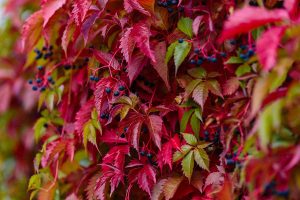
Virginia creeper (Parthenocissus quinquefolia) is a fast-growing, deciduous vine that is native to North America. It is a member of the grape family (Vitaceae) and is closely related to other popular vines such as poison ivy (Toxicodendron radicans) and grapevines (Vitis spp.). It is a vigorous, fast-growing, deciduous woody vine that typically climbs 30-50 feet (9-15 m) tall or more in trees, shrubs, and other supports. It has intermediate resistance to drought and salt. The leaves are arranged alternately and are compounded with five ovate-lanceolate leaflets (3-6 inches long). Clusters of small greenish flowers appear in late spring, followed by dark blue fruits in early fall. The fruit is an important food source for many birds and other animals. Virginia creeper is a versatile plant that can be used as a ground cover, climber, or ornamental. It is relatively easy to grow and is tolerant of a wide range of soil and light conditions.
How to Grow Ground Covers in Virginia
Ground cover plants are an essential part of any garden. Not only do they add beauty and interest, but they also help to protect the soil from erosion. There are several factors to consider when selecting and planting ground cover plants.
When choosing ground cover plants for Virginia, it is important to consider the amount of sun and shade the area receives. Some ground cover plants need full sun, while others do better in partial shade. It is also important to choose a plant that is tolerant of Virginia’s hot, humid summers. Once you have chosen the right plant for the location, you will need to prepare the soil. The best way to do this is to loosen the top layer of soil with a shovel or tiller. This will help the roots of the plant to take hold. Next, you will need to add a layer of organic matter, such as compost or peat moss. This will help the ground cover plant to retain moisture. Finally, you will need to water the area thoroughly before planting.
Most ground cover plants spread rapidly, so it is best to plant them in an area where they will have room to spread out without crowding other plants. Ground cover plants should be planted 12-18 inches apart and mulched with a 2-inch layer of straw or bark chips. Once planted, ground cover plants require little maintenance other than occasional watering during periods of extended drought.
Bottom Line
Ground Covers could be an excellent addition to any garden. They help with erosion, add beauty, and come in various shapes and colors. This article has provided just some species that could thrive in Virginia. Do your research before planting to ensure you are getting the right plant for your needs.

